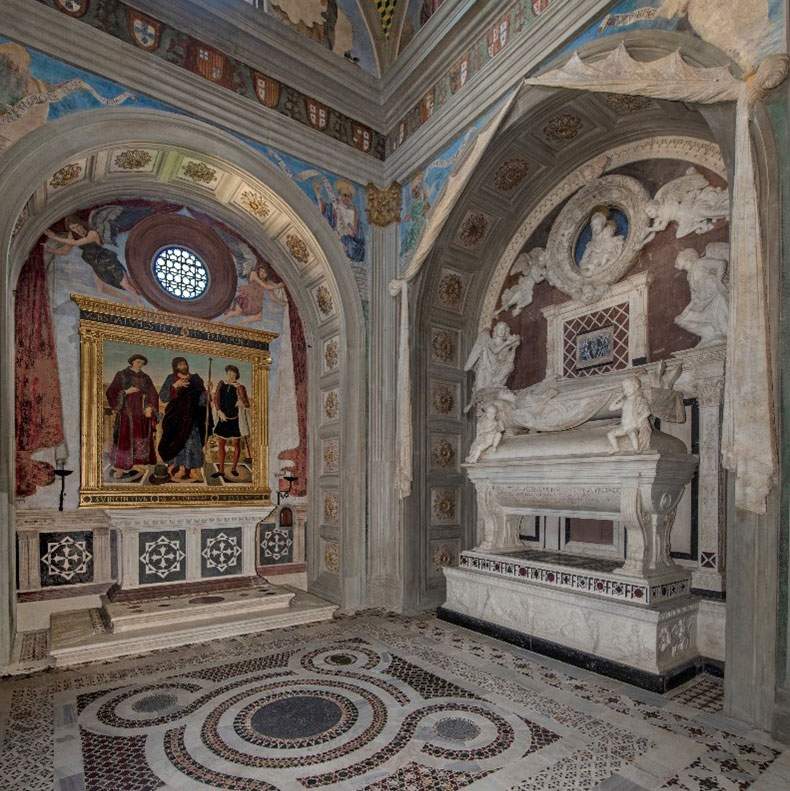The Chapel of the Cardinal of Portugal in theAbbey of San Miniato al Monte, a masterpiece of the Florentine Renaissance, has been restored. The lengthy restoration was carried out under the supervision of Maria Maugeri with the Superintendence of Archaeology Fine Arts for the Metropolitan City of Florence and the Provinces of Pistoia and Prato; the three-year project was made possible thanks to a team of experts and thanks to funding from the Friends of Florence association.
Cutting-edge technologies and ancient techniques were used: after careful investigations and assessments carried out on the entire space, the team of experts recovered the surfaces and details of paintings by Alesso Baldovinetti and Piero and Antonio del Pollaiolo, works by Antonio Rossellino and terracotta masterpieces by Luca della Robbia.
“San Miniato al Monte is special for Friends of Florence,” said association president Simonetta Brandolini d’Adda. “Three years ago we contributed to the restoration of the ciborium on the occasion of the church’s first millennium. Now, with the presentation of the renovated Chapel of the Cardinal of Portugal, we are promoting our commitment to preserve the Abbey.”
Abbot Bernardo Gianni added, “The community of San Miniato al Monte is profoundly grateful to the Friends of Florence and the donors who made this restoration undertaking possible, restoring to its original beauty one of the most illustrious monuments of all Renaissance art and of the millennial history of San Miniato al Monte, thus helping to make beauty and its preservation a wonderful instrument of consolation and hope in the face of the mystery of death.”
The Chapel of the Cardinal of Portugal is one of the most important Florentine Renaissance chapels. Located in the church of San Miniato al Monte, it was built in the middle decades of the 15th century on the will of Cardinal James of Lusitania, a member of the Portuguese royal house who died suddenly in Florence in 1459. Commissioned by Archbishop Alvaro to Antonio Rossellino in 1461, the design and construction of the chapel and tomb were entrusted to a group of artists, including Luca della Robbia, Antonio Manetti (a pupil of Brunelleschi, Antonio and Piero del Pollaiolo, Antonio and Bernardo Rossellino, and Alesso Baldovinetti.
The relatively small and square space has a vaulted ceiling, windows, and four coffered arches decorated with 69 rosettes in pietra serena. The inlaid floor was made by Roman craftsman Stefano di Bartolomeo from serpentine marble, porphyry, and granite. The vaulted ceiling has a geometric motif in glazed terracotta imitating mosaic with a central roundel depicting the Holy Spirit; around it are embossed personifications of the four cardinal virtues: Temperance, Prudence, Justice and Fortitude; the latter shows a shield on which the arms of the deceased cardinal are crossed with those of the House of Aragon.
The depiction of a large marble curtain introduces visitors to the niche in which the tomb rests on a base covered with finely “embroidered” drapery. In the course of restoration, traces of original painting and gilding were found. The top of the tomb depicts the young cardinal, his features sculpted from a death mask. Angels in flight frame the door that leads the cardinal to eternal life, while the final register includes two angels in relief holding a crown in which the Virgin watches over his eternal resting place with Baby Jesus.
After completing the right wall with a final payment of 421 florins in February 1466, Antoniop Rossellino devoted the next few months to the opposite wall where, in a niche mirroring the other wall, he placed an episcopal throne with inscriptions on the sides.
Around the arches are frescoes of the Evangelists accompanied by the Doctors of the Church, and the lunettes of the chapel depict the Prophets facing the biblical Patriarchs. Purchased by the Florentine Galleries in 1866 and replaced by a good copy in the 1930s, the altarpiece depicts St. James the Greater, the young cardinal’s personal patron, St. Eustace, patron of the church of which the cardinal was titular, and St. Vincent of Zaragoza, who was highly venerated in the Iberian Peninsula.
 |
| The Chapel of the Cardinal of Portugal in San Miniato al Monte, a masterpiece of the Florentine Renaissance, has been restored |
Warning: the translation into English of the original Italian article was created using automatic tools. We undertake to review all articles, but we do not guarantee the total absence of inaccuracies in the translation due to the program. You can find the original by clicking on the ITA button. If you find any mistake,please contact us.